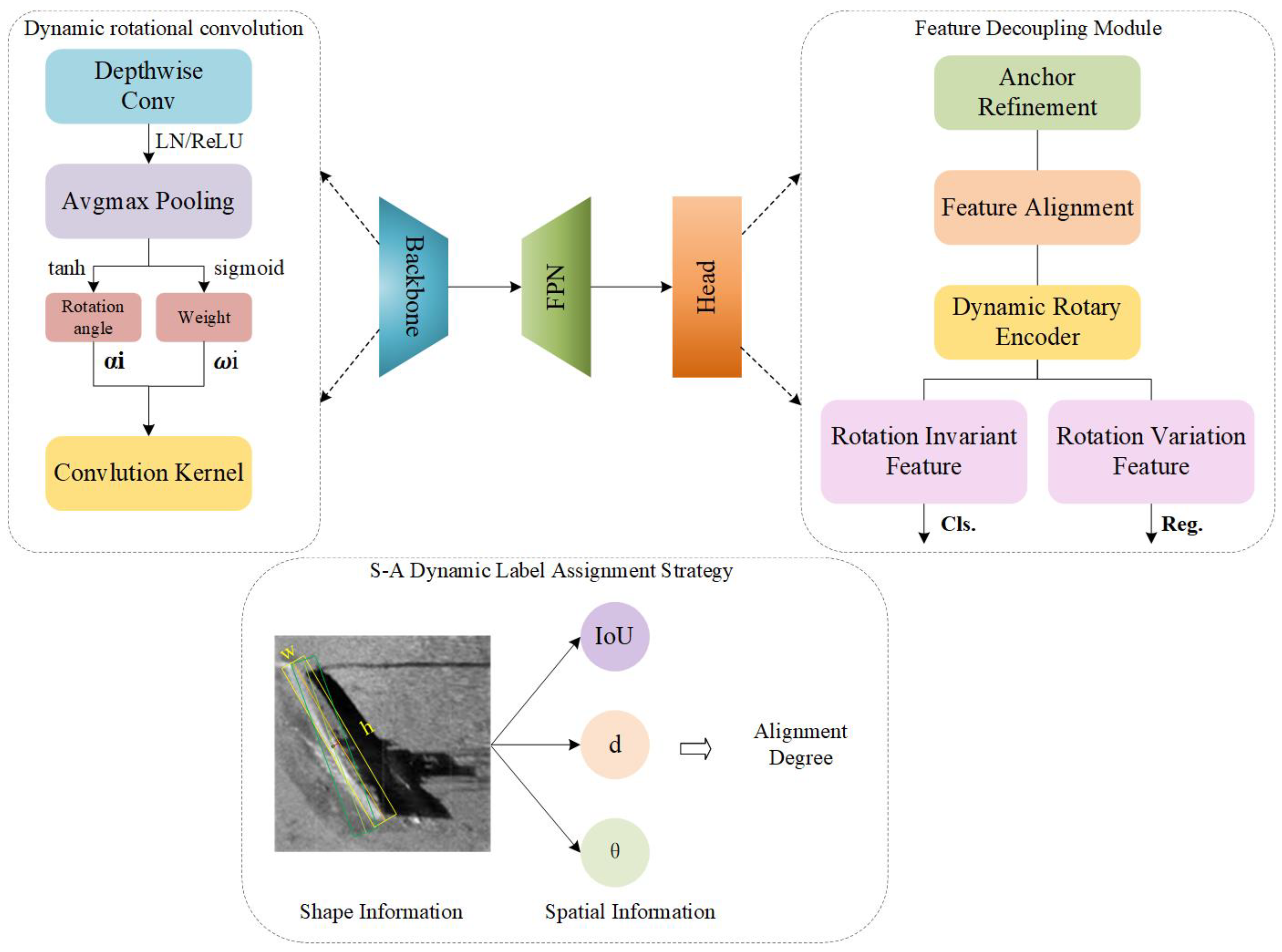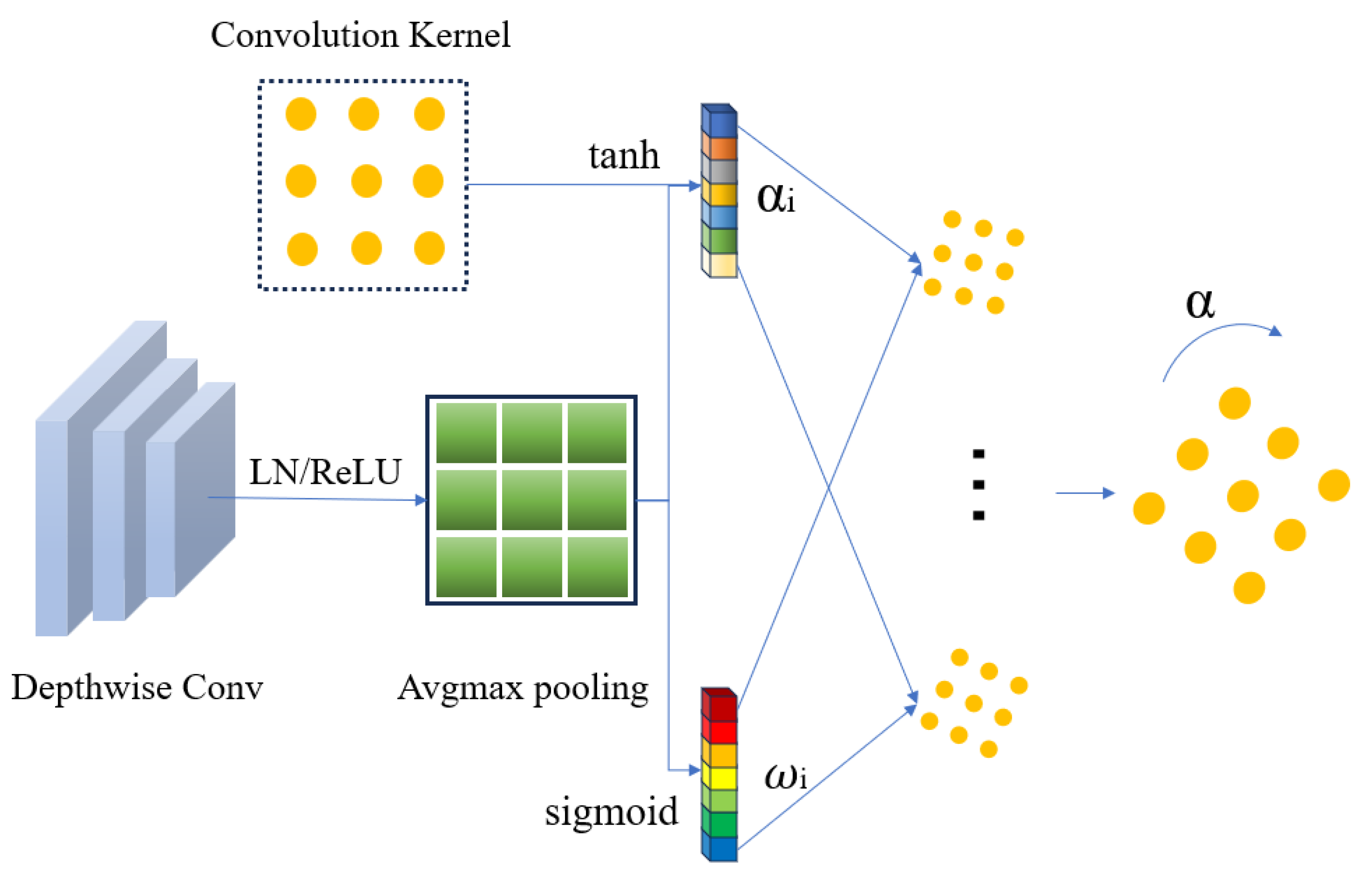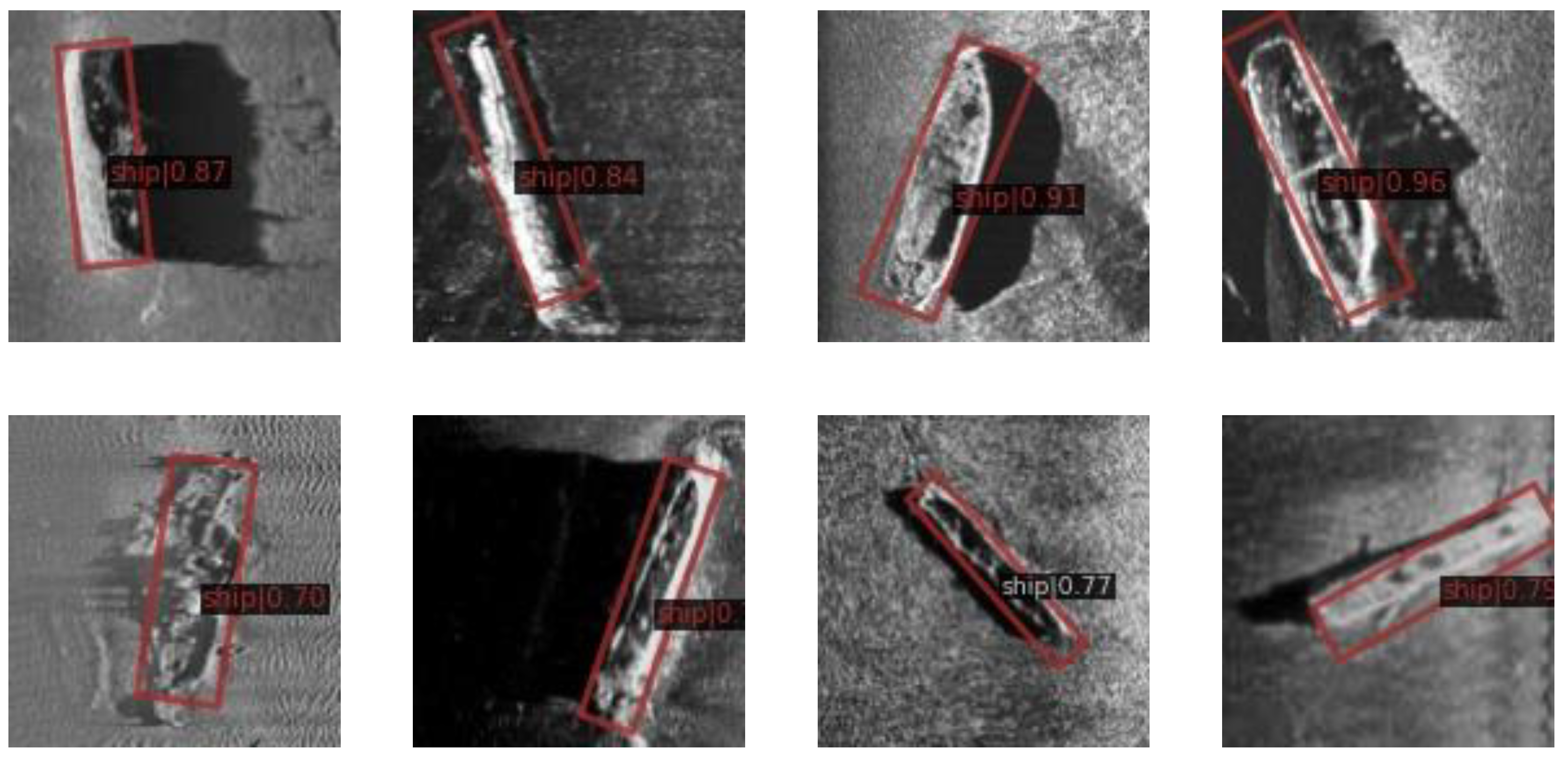S3DR-Det: A Rotating Target Detection Model for High Aspect Ratio Shipwreck Targets in Side-Scan Sonar Images
Abstract
1. Introduction
2. Related Work
2.1. Oriented Object Detection
2.2. Sample Selection for Object Detection
3. Method
3.1. Network Architecture
3.2. Dynamic Rotational Convolution Module
3.3. Feature Decoupling Module
3.4. S-A Dynamic Label Assignment Strategy
4. Experiment and Results
4.1. Dataset
4.2. Implementation Details
Evaluation Metrics
4.3. Results
Comparison of S3DR-Det with Existing Methods
4.4. Ablation Study
4.4.1. FDM
4.4.2. S-A
5. Conclusions
Author Contributions
Funding
Institutional Review Board Statement
Informed Consent Statement
Data Availability Statement
Acknowledgments
Conflicts of Interest
References
- Tang, Y.; Li, H.; Zhang, W.; Bian, S.; Zhai, G.; Liu, M.; Zhang, X. Light weight DETR-YOLO method for detecting shipwreck target in side-scan sonar. Syst. Eng. Electron. 2022, 44, 2427–2436. [Google Scholar]
- Yu, Y.; Zhao, J.; Gong, Q.; Huang, C.; Zheng, G.; Ma, J. Real-Time Underwater Maritime Object Detection in Side-Scan Sonar Images Based on Transformer-YOLOv5. Remote Sens. 2021, 13, 3555. [Google Scholar] [CrossRef]
- Yulin, T.; Jin, S.; Bian, G.; Zhang, Y. Shipwreck Target Recognition in Side-Scan Sonar Images by Improved YOLOv3 Model Based on Transfer Learning. IEEE Access 2020, 8, 173450–173460. [Google Scholar] [CrossRef]
- Yulin, T.; Shaohua, J.; Gang, B.; Yonzhou, Z.; Fan, L. Wreckage Target Recognition in Side-scan Sonar Images Based on an Improved Faster R-CNN Model. In Proceedings of the 2020 International Conference on Big Data & Artificial Intelligence & Software Engineering (ICBASE), Bangkok, Thailand, 30 October–1 November 2020; pp. 348–354. [Google Scholar] [CrossRef]
- Yulin, T.; Shaohua, J.; Fuming, X.; Gang, B.; Yonghou, Z. Recognition of Side-scan Sonar Shipwreck Image Using Convolutional Neural Network. In Proceedings of the 2020 2nd International Conference on Machine Learning, Big Data and Business Intelligence (MLBDBI), Taiyuan, China, 23–25 October 2020; pp. 529–533. [Google Scholar] [CrossRef]
- Ma, Q.; Jin, S.; Bian, G.; Cui, Y. Multi-Scale Marine Object Detection in Side-Scan Sonar Images Based on BES-YOLO. Sensors 2024, 24, 4428. [Google Scholar] [CrossRef]
- Tang, Y.; Wang, L.; Jin, S.; Zhao, J.; Huang, C.; Yu, Y. AUV-Based Side-Scan Sonar Real-Time Method for Underwater-Target Detection. J. Mar. Sci. Eng. 2023, 11, 690. [Google Scholar] [CrossRef]
- Kong, W.; Hong, J.; Jia, M.; Yao, J.; Cong, W.; Hu, H. YOLOv3-DPFIN: A Dual-Path Feature Fusion Neural Network for Robust Real-Time Sonar Target Detection. IEEE Sens. J. 2020, 20, 3745–3756. [Google Scholar] [CrossRef]
- Zhao, J.; Li, J.; Li, M. Progress and Future Trend of Hydrographic Surveying and Charting. J. Geomat. 2009, 34, 25–27. [Google Scholar]
- Wang, J.; Cao, J.; Lu, B.; He, B. Underwater Target Detection Project Equipment Application and Development Trend. China Water Transp. 2016, 11, 43–44. [Google Scholar]
- Wang, X.; Wang, A.; Jiang, T. Review of application areas for side scan sonar image. Surv. Mapp. Bull. 2019, 1, 1–4. [Google Scholar] [CrossRef]
- Wang, J.; Zhou, J. Comprehensive Application of Side-scan Sonar and Multi-beam System in Shipwreck Survey. China Water Transp. 2010, 10, 35–37. [Google Scholar]
- Lu, Z.; Zhu, T.; Zhou, H.; Zhang, L.; Jia, C. An Image Enhancement Method for Side-Scan Sonar Images Based on Multi-Stage Repairing Image Fusion. Electronics 2023, 12, 3553. [Google Scholar] [CrossRef]
- Xie, Y.; Bore, N.; Folkesson, J. Bathymetric Reconstruction From Sidescan Sonar With Deep Neural Networks. IEEE J. Ocean. Eng. 2023, 48, 372–383. [Google Scholar] [CrossRef]
- Neupane, D.; Seok, J. A Review on Deep Learning-Based Approaches for Automatic Sonar Target Recognition. Elecronics 2020, 9, 1972. [Google Scholar] [CrossRef]
- Yang, D.; Wang, C.; Cheng, C.; Pan, G.; Zhang, F. Semantic Segmentation of Side-Scan Sonar Images with Few Samples. Electronics 2022, 11, 3002. [Google Scholar] [CrossRef]
- Hsu, W.-Y.; Lin, W.-Y. Ratio-and-Scale-Aware YOLO for Pedestrian Detection. IEEE Trans. Image Process. 2021, 30, 934–947. [Google Scholar] [CrossRef]
- Li, T.; Zhang, Z.; Zhu, M.; Cui, Z.; Wei, D. Combining transformer global and local feature extraction for object detection. Complex Intell. Syst. 2024, 10, 4897–4920. [Google Scholar] [CrossRef]
- Zhang, M.; Xu, S.; Song, W.; He, Q.; Wei, Q. Lightweight Underwater Object Detection Based on YOLO v4 and Multi-Scale Attentional Feature Fusion. Remote Sens. 2021, 13, 4706. [Google Scholar] [CrossRef]
- Dong, X.; Yan, S.; Duan, C. A lightweight vehicles detection network model based on YOLOv5. Eng. Appl. Artif. Intell. 2022, 113, 104914. [Google Scholar] [CrossRef]
- Girshick, R.; Donahue, J.; Darrell, T.; Malik, J. Rich Feature Hierarchies for Accurate Object Detection and Semantic Segmentation. In Proceedings of the 2014 IEEE Conference on Computer Vision and Pattern Recognition, Columbus, OH, USA, 23–24 June 2013; pp. 580–587. [Google Scholar]
- Liu, W.; Anguelov, D.; Erhan, D.; Szegedy, C.; Reed, S.; Fu, C.; Berg, A.C. SSD: Single Shot MultiBox Detector. In Computer Vision—ECCV 2016. ECCV 2016. Lecture Notes in Computer Science; Leibe, B., Matas, J., Sebe, N., Welling, M., Eds.; Springer: Cham, Switzerland, 2016; Volume 9905. [Google Scholar] [CrossRef]
- Redmon, J.; Divvala, S.; Girshick, R.; Farhadi, A. You Only Look Once: Unified, Real-Time Object Detection. In Proceedings of the 2016 IEEE Conference on Computer Vision and Pattern Recognition (CVPR), Las Vegas, NV, USA, 26–30 June 2016; pp. 779–788. [Google Scholar]
- Redmon, J.; Ali, F. YOLOv3: An Incremental Improvement. arXiv 2018, arXiv:1804.02767. [Google Scholar]
- Liu, Z.; Wang, H.; Weng, L.; Yang, Y. Ship Rotated Bounding Box Space for Ship Extraction From High-Resolution Optical Satellite Images With Complex Backgrounds. IEEE Geosci. Remote Sens. Lett. 2016, 13, 1074–1078. [Google Scholar] [CrossRef]
- Zhang, Z.; Guo, W.; Zhu, S.; Yu, W. Toward Arbitrary-Oriented Ship Detection With Rotated Region Proposal and Discrimination Networks. IEEE Geosci. Remote Sens. Lett. 2018, 15, 1745–1749. [Google Scholar] [CrossRef]
- Deng, L.; Gong, Y.; Lu, X.; Lin, Y.; Ma, Z.; Xie, M. STELA: A Real-Time Scene Text Detector With Learned Anchor. IEEE Access 2019, 7, 153400–153407. [Google Scholar] [CrossRef]
- Yang, X.; Fu, K.; Sun, H.; Yang, J. R2CNN++: Multi-Dimensional Attention Based Rotation Invariant Detector with Robust Anchor Strategy. arXiv 2018, arXiv:1811.07126. [Google Scholar]
- Ding, J.; Xue, N.; Long, Y.; Xia, G.; Lu, Q. Learning RoI Transformer for Detecting Oriented Objects in Aerial Images. arXiv 2018, arXiv:1812.00155. [Google Scholar]
- Ma, J.; Shao, W.; Ye, H.; Wang, L.; Wang, H.; Zheng, Y.; Xue, X. Arbitrary-Oriented Scene Text Detection via Rotation Proposals. IEEE Trans. Multimed. 2017, 20, 3111–3122. [Google Scholar] [CrossRef]
- Yang, X.; Zhang, G.; Yang, X.; Zhou, Y.; Wang, W.; Tang, J.; He, T.; Yan, J. Detecting Rotated Objects as Gaussian Distributions and its 3-D Generalization. IEEE Trans. Pattern Anal. Mach. Intell. 2023, 45, 4335–4354. [Google Scholar] [CrossRef]
- Yang, X.; Zhou, Y.; Zhang, G.; Yang, J.; Wang, W.; Yan, J.; Zhang, X.; Tian, Q. The KFIoU Loss for Rotated Object Detection. arXiv 2022, arXiv:2201.12558. [Google Scholar]
- Yi, Y.; Da, F. Phase-Shifting Coder: Predicting Accurate Orientation in Oriented Object Detection. In Proceedings of the 2023 IEEE/CVF Conference on Computer Vision and Pattern Recognition (CVPR), Vancouver, BC, Canada, 17–24 June 2022; pp. 13354–13363. [Google Scholar]
- Zhang, G.; Lu, S.; Zhang, W. CAD-Net: A Context-Aware Detection Network for Objects in Remote Sensing Imagery. IEEE Trans. Geosci. Remote Sens. 2019, 57, 10015–10024. [Google Scholar] [CrossRef]
- Xu, Y.; Fu, M.; Wang, Q.; Wang, Y.; Chen, K.; Xia, G.-S.; Bai, X. Gliding Vertex on the Horizontal Bounding Box for Multi-Oriented Object Detection. IEEE Trans. Pattern Anal. Mach. Intell. 2021, 43, 1452–1459. [Google Scholar] [CrossRef] [PubMed]
- Pu, Y.; Wang, Y.; Xia, Z.; Han, Y.; Wang, Y.; Gan, W.; Wang, Z.; Song, S.; Huang, G. Adaptive Rotated Convolution for Rotated Object Detection. In Proceedings of the 2023 IEEE/CVF International Conference on Computer Vision (ICCV), Vancouver, BC, Canada, 17–24 June 2022; pp. 6566–6577. [Google Scholar]
- Han, J.; Ding, J.; Xue, N.; Xia, G.-S. ReDet: A Rotation-equivariant Detector for Aerial Object Detection. In Proceedings of the 2021 IEEE/CVF Conference on Computer Vision and Pattern Recognition (CVPR), Nashville, TN, USA, 20–25 June 2021; pp. 2785–2794. [Google Scholar] [CrossRef]
- Yang, X.; Yan, J.; Feng, Z.; He, T. R3Det: Refined Single-Stage Detector with Feature Refinement for Rotating Object. arXiv 2019, arXiv:1908.05612. [Google Scholar] [CrossRef]
- Pan, X.; Ren, Y.; Sheng, K.; Dong, W.; Yuan, H.; Guo, X.; Ma, C.; Xu, C. Dynamic Refinement Network for Oriented and Densely Packed Object Detection. In Proceedings of the 2020 IEEE/CVF Conference on Computer Vision and Pattern Recognition (CVPR), Seattle, WA, USA, 13–19 June 2020; pp. 11204–11213. [Google Scholar]
- Han, J.; Ding, J.; Li, J.; Xia, G.-S. Align Deep Features for Oriented Object Detection. IEEE Trans. Geosci. Remote Sens. 2022, 60, 1–11. [Google Scholar] [CrossRef]
- Yang, X.; Yan, J. On the Arbitrary-Oriented Object Detection: Classification Based Approaches Revisited. Int. J. Comput. Vis. 2022, 130, 1340–1365. [Google Scholar] [CrossRef]
- Zhu, Y.; Du, J.; Wu, X. Adaptive Period Embedding for Representing Oriented Objects in Aerial Images. IEEE Trans. Geosci. Remote Sens. 2020, 58, 7247–7257. [Google Scholar] [CrossRef]
- Zhang, S.; Chi, C.; Yao, Y.; Lei, Z.; Li, S.Z. Bridging the Gap Between Anchor-Based and Anchor-Free Detection via Adaptive Training Sample Selection. In Proceedings of the 2020 IEEE/CVF Conference on Computer Vision and Pattern Recognition (CVPR), Seattle, WA, USA, 13–19 June 2020; pp. 9756–9765. [Google Scholar]
- Hou, L.; Lu, K.; Xue, J.; Li, Y. Shape-Adaptive Selection and Measurement for Oriented Object Detection. In Proceedings of the AAAI Conference on Artificial Intelligence, Vancouver, BC, Canada, 22 February–1 March 2022; Volume 36, pp. 923–932. [Google Scholar] [CrossRef]
- Ming, Q.; Zhou, Z.; Miao, L.; Zhang, H.; Li, L. Dynamic Anchor Learning for Arbitrary-Oriented Object Detection. arXiv 2020, arXiv:2012.04150. [Google Scholar] [CrossRef]
- Huang, Z.; Li, W.; Xia, X.-G.; Tao, R. A General Gaussian Heatmap Label Assignment for Arbitrary-Oriented Object Detection. IEEE Trans. Image Process. 2022, 31, 1895–1910. [Google Scholar] [CrossRef]
- Li, W.; Zhu, J. Oriented RepPoints for Aerial Object Detection. In Proceedings of the 2022 IEEE/CVF Conference on Computer Vision and Pattern Recognition (CVPR), Vancouver, BC, Canada, 17–24 June 2022; pp. 1819–1828. [Google Scholar]
- Xiao, Z.; Wang, K.; Wan, Q.; Tan, X.; Xu, C.; Xia, F. A2S-Det: Efficiency Anchor Matching in Aerial Image Oriented Object Detection. Remote Sens. 2021, 13, 73. [Google Scholar] [CrossRef]
- Peng, C.; Jin, S.; Bian, G.; Cui, Y. SIGAN: A Multi-Scale Generative Adversarial Network for Underwater Sonar Image Super-Resolution. J. Mar. Sci. Eng. 2024, 12, 1057. [Google Scholar] [CrossRef]








| Model | Dataset | R (%) | AP (%) | Dataset | R (%) | AP (%) | |
|---|---|---|---|---|---|---|---|
| two-stage | RoI Transformer | SSUTD | 91.83 | 89.19 | DNASI | 90.85 | 87.64 |
| Oriented R-CNN | 91.23 | 88.76 | 90.50 | 85.82 | |||
| Rotated Faster R-CNN | 86.77 | 74.98 | 86.12 | 73.64 | |||
| Gliding Vertex | 75.68 | 63.12 | 78.74 | 64.28 | |||
| CFA | 86.12 | 73.64 | 87.33 | 75.87 | |||
| one-stage | Rotated RetinaNet | SSUTD | 81.53 | 76.21 | DNASI | 83.58 | 76.28 |
| S2Anet | 88.74 | 81.06 | 87.52 | 79.63 | |||
| ATSS | 83.1 | 76.7 | 83.37 | 75.92 | |||
| DRN | 83.58 | 76.28 | 85.12 | 77.56 | |||
| R3Det | 84.11 | 77.75 | 81.53 | 76.21 | |||
| R3Det-KFIoU | 87.52 | 79.63 | 89.16 | 81.20 | |||
| S3DR-Det | 92.70 | 89.68 | 93.98 | 90.19 |
| AFO | DRM | R (%) | AP (%) |
|---|---|---|---|
| √ | - | 90.12 | 87.24 |
| - | √ | 88.98 | 86.12 |
| √ | √ | 92.70 | 89.68 |
| α | β | γ | AP (%) |
|---|---|---|---|
| 0.4 | 0.3 | 0.3 | 88.42 |
| 0.2 | 0.4 | 83.15 | |
| 0.1 | 0.5 | 79.54 | |
| 0.5 | 0.3 | 0.2 | 88.82 |
| 0.2 | 0.3 | 89.68 | |
| 0.1 | 0.4 | 84.10 | |
| 0.6 | 0.3 | 0.1 | 77.95 |
| 0.2 | 0.2 | 83.62 | |
| 0.1 | 0.3 | 75.56 |
| DRC | FDM | S-A | R (%) | AP (%) |
|---|---|---|---|---|
| - | - | - | 88.74 | 81.06 |
| √ | √ | - | 90.54 | 85.41 |
| √ | - | √ | 90.69 | 85.92 |
| - | √ | √ | 89.48 | 84.38 |
| √ | √ | √ | 92.70 | 89.68 |
Disclaimer/Publisher’s Note: The statements, opinions and data contained in all publications are solely those of the individual author(s) and contributor(s) and not of MDPI and/or the editor(s). MDPI and/or the editor(s) disclaim responsibility for any injury to people or property resulting from any ideas, methods, instructions or products referred to in the content. |
© 2025 by the authors. Licensee MDPI, Basel, Switzerland. This article is an open access article distributed under the terms and conditions of the Creative Commons Attribution (CC BY) license (https://creativecommons.org/licenses/by/4.0/).
Share and Cite
Ma, Q.; Jin, S.; Bian, G.; Cui, Y.; Liu, G.; Wang, Y. S3DR-Det: A Rotating Target Detection Model for High Aspect Ratio Shipwreck Targets in Side-Scan Sonar Images. Remote Sens. 2025, 17, 312. https://doi.org/10.3390/rs17020312
Ma Q, Jin S, Bian G, Cui Y, Liu G, Wang Y. S3DR-Det: A Rotating Target Detection Model for High Aspect Ratio Shipwreck Targets in Side-Scan Sonar Images. Remote Sensing. 2025; 17(2):312. https://doi.org/10.3390/rs17020312
Chicago/Turabian StyleMa, Quanhong, Shaohua Jin, Gang Bian, Yang Cui, Guoqing Liu, and Yihan Wang. 2025. "S3DR-Det: A Rotating Target Detection Model for High Aspect Ratio Shipwreck Targets in Side-Scan Sonar Images" Remote Sensing 17, no. 2: 312. https://doi.org/10.3390/rs17020312
APA StyleMa, Q., Jin, S., Bian, G., Cui, Y., Liu, G., & Wang, Y. (2025). S3DR-Det: A Rotating Target Detection Model for High Aspect Ratio Shipwreck Targets in Side-Scan Sonar Images. Remote Sensing, 17(2), 312. https://doi.org/10.3390/rs17020312






